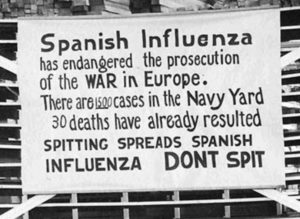Continua la collaborazione tra il liceo linguistico "Cattaneo dall'Aglio" e Redacon tramite la rubrica "Speakeasy" curata direttamente dagli studenti, dell'anno scolastico 2019-2020.
Coronavirus: what can we learn from the spanish flu?
In these days, full of worries, fears and doubts caused by the increasing number of cases of COVID-19 all around the world, The Guardian published an article on the 3rd of march in which we can learn more about this terrible virus. This can happen thanks to a direct comparison with what happened when the Spanish flu spread in 1918-1919 killing between 50 million and 100 million people.
We can sum up in four points what we must keep in mind when we talk about Coronavirus.
How to properly name a pandemic

So, lesson number one: we must be careful while naming a pandemic, because even if it is said to arise first in a certain place, most of the time it didn’t. Though it has to be said that this time Wuhan might actually be the place where the virus originated. However, it is not so easy to be 100% sure about the true origin of a pandemic and it is better not to call it with a name directly related to a certain country: it could generate some forms of racism, giving place to prejudice that can last forever.
The importance of warning the public

In fact, as we learned, at the time of the Spanish flu authorities got it wrong because they didn’t make people aware of what Spanish flu really was. Those were the years of the First World War and the leaders of the time didn’t want people to be worried, so they tried not to alarm the population, but as a consequence the flu spread and affected many people.
But what about COVID-19? It is important to be well-informed and to be interested in learning always more; but we should make sure the information is reliable. It is indeed quite usual to hear fake news about current issues but if we check the source of the news, as with the newscast, we shouldn’t worry much. Up to now, many scientists are studying the virus and every day they give us advice which can be useful to safeguard our health, we should only follow this advice correctly.
It is also true that sometimes COVID-19 is being used as a political device and it is not taken seriously enough by politicians.
To sum up, from the Spanish flu we can learn that it is essential to get informed about what the virus really is and what we should do to limit its spread. Nowadays, many sources are easily accessible to everyone, in fact, thanks to technology we can find every information that we need in real time, but we must take an interest in it! The lack of concern is the real battle to win.
How uncontrolled movement can make matters worse
Another lesson learnt from the Spanish flu is that uncontrolled movement can lead to tragic outcomes. In 1918, the Spanish flu managed to get spread thanks to the First World War, when a lot of infected soldiers were sent home. In fact a lot of countries had to clamp down on their cities to save the residents. Unfortunately, some countries were slower. For instance, in New Zealand nearly 1% of the population died within two months in late 1918, because the authorities of the country had not been quick enough in locking their ports, triggering a tragic outbreak in Pacific territories, where the situation would get even worse.

Probably this can appear exaggerated, but surely it’s also the best way to prevent a big epidemic, which is for sure more important than a called off football match.
A possible second wave
We know that even if the first appearance of Spanish flu in spring 1918 wasn’t that bad, in August there was a second wave, when the virus became deadlier and hit regions which hadn’t been exposed to it before, so with people having fewer possibility to heal.
What we hope now is that COVID-19 doesn't appear again, because of the possible increase in its effects. However, there are some differences between Spanish flu and coronaviruses. In fact, unlike flu which constantly shuffles its genomes, that’s why we need new vaccines every year, coronaviruses are genetically quite stable. For this reason, a sudden shift in the mortality rate of COVID-19 is considered improbable. But will this virus disappear, reappear in waves or simmer in the background as an endemic illness? This is not so sure even for experts.
The potential for a second wave is determined by its transmission which depends on temperature and humidity. But because of the geographic spread the possibility of a second wave is now questionable.
Prof. Julia Gog said “the argument that we’ll be safer as we move towards the summer doesn’t make sense”, she states that COVID-19 may reappear in a second wave, but not on account of climate.
Is it just because of that? Sure not, in fact, long-term immunity of people who have been infected once plays an important role in this argument. If this happens there will be a chance not to have a second emergence.
However, as case numbers rise continuously, scientists are paying always more attention to it. For example, by analysing the case of a Japanese woman, who got the virus twice, it has been noticed that immunity declines after recovery and for this reason a second wave is more likely to happen.
(Sara Incerti Parenti, Arianna Fontana, Lorenzo Nobili, Gaia Fontanili. 5R e 5Q)
*****
Traduzione
Coronavirus: cosa possiamo imparare dall’ influenza spagnola?

Come dare un nome adeguato a una pandemia
Innanzitutto, come abbiamo visto, da quando la malattia si è diffusa a partire dalla Cina, sono accaduti atti di razzismo contro persone cinesi, considerate “colpevoli” e sapete cosa? Questo tipo di cose accadde in un qualche modo anche nel 1918, perché anche se la malattia era iniziata negli Stati Uniti e i soldati americani l’avevano portata in Europa, in particolare nelle trincee tedesche, francesi e inglesi, fu chiamata Influenza Spagnola. Questo perché i paesi che stavano combattendo nella guerra non volevano mostrare debolezze e così tennero l’epidemia nascosta. Fu solo quando la malattia arrivò nel neutrale paese iberico che notizie cominciarono a emergere, di conseguenza essa fu erroneamente identificata come se fosse stata diffusa dalla Spagna e “questo fu motivo di offesa per molto tempo”, come ha detto la prof.ssa Julia Gog, matematica dell’università di Cambridge.
Quindi, lezione numero uno: dobbiamo prestare attenzione nel dare un nome a una pandemia, perché anche se si dice che sia nata in un certo luogo, la maggior parte delle volte non lo è. Va comunque detto che questa volta Wuhan potrebbe essere davvero il posto in cui il virus si è originato. Tuttavia, non è facile essere sicuri al 100% riguardo le reali origini di una pandemia ed è meglio non chiamarla con un nome direttamente legato ad un certo paese: potrebbe generare alcune forme di razzismo, dando luogo a pregiudizi che possono durare in eterno.
L’importanza di avvisare il pubblico
Inoltre, il passato può essere utile perché può insegnarci a non commettere errori sciocchi che sono già stati commessi in passato. Infatti, come abbiamo imparato, al tempo dell’influenza spagnola, le autorità sbagliarono perché non fecero sì che le persone fossero veramente consapevoli di cosa fosse davvero l’influenza spagnola. Quelli erano gli anni della prima guerra mondiale e le autorità del tempo non volevano che le popolazioni si preoccupassero, quindi cercarono di non creare allarme, ma di conseguenza l’influenza si diffuse e infettò molte persone.
Ma che dire del COVID-19? E’ molto importante essere ben informati e interessarsi a sapere sempre di più; ma dobbiamo anche essere sicuri che le informazioni siano attendibili. E’ infatti abbastanza usuale sentire fake news a proposito dei problemi attuali ma se controlliamo con attenzione le fonti delle notizie, come il telegiornale, non dobbiamo preoccuparci troppo. Tutt’ora, molti scienziati stanno studiando il virus, e ogni giorno ci forniscono consigli che possono essere utili a salvaguardare la nostra salute, basta solo seguire questi consigli in modo corretto.
Inoltre, è anche vero che qualche volta il COVID-19 viene usato come mezzo politico e non è preso abbastanza seriamente dai politici.
Per concludere, dall’influenza spagnola si può imparare che è essenziale essere informati a proposito di cosa il virus sia veramente e cosa dovremmo fare per limitare la sua diffusione. Oggigiorno sono molte le fonti facilmente accessibili a tutti, infatti, grazie alla tecnologia possiamo trovare tutte le informazioni di cui abbiamo bisogno in tempo reale, ma bisogna mostrarsi interessati! La mancanza di interesse è spesso la vera battaglia da vincere.
Come può un movimento incontrollato rendere peggiore la situazione

D’altra parte, il coronavirus si è direttamente diffuso nella quotidianità, grazie alla globalizzazione. Come abbiamo detto prima, noi dobbiamo imparare dalla storia e per fortuna molte nazioni stanno chiudendo le loro città. Per esempio in Italia stiamo bloccando tutto come città, scuole, luoghi dove molte persone si riuniscono (ex. eventi sportivi).
Probabilmente ciò potrebbe sembrare esagerato, ma sicuramente è anche il miglior modo per evitare un’epidemia, tutto ciò è certamente più importante di una partita di calcio cancellata.
Una possibile seconda ondata
Sappiamo che anche se la prima apparizione dell’influenza Spagnola della primavera del 1918 non fu così letale, in agosto ci fu una seconda ondata, quando il virus diventò più letale e colpì regioni che non erano state esposte prima, quindi con persone più soggette a esiti letali.

La possibilità di una seconda ondata è determinata dalla sua trasmissione che dipende dalla temperatura e dall’umidità. A causa della diffusione geografica, però, la possibilità di una seconda ondata è al momento non chiara.
La prof.ssa Julia Gog ha detto “il ragionamento che saremo più al sicuro andando verso l’estate non ha senso”, e precisa che COVID-19 potrebbe apparire nuovamente in una seconda ondata, ma non per via del clima.
È solo per questo motivo? No di certo: infatti, l’immunità a lungo termine delle persone che sono state contaminate una volta gioca un ruolo importante in questa situazione. Se questo accade ci sarà la possibilità di non avere una seconda comparsa.
A ogni modo, dato che i numeri dei casi aumentano continuamente, gli scienziati stanno lavorando con sempre maggiore attenzione. Per esempio, analizzando il caso di una donna giapponese, che ha contratto il virus due volte, si è notato che l’immunità cala dopo la guarigione e per questo motivo è più probabile che si verifichi una seconda ondata.
(Sara Incerti Parenti, Arianna Fontana, Lorenzo Nobili, Gaia Fontanili. 5R e 5Q)
Bibliografia: The Guardian “Four lessons the Spanish flu can teach us about coronavirus”







